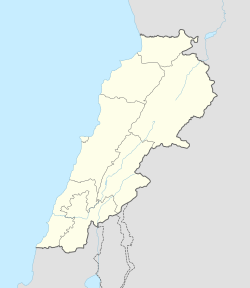Hariss
|
Hariss حاريص |
|
|---|---|
| Village | |
| Location within Lebanon | |
| Coordinates: 33°10′28.2″N 35°22′35.76″E / 33.174500°N 35.3766000°ECoordinates: 33°10′28.2″N 35°22′35.76″E / 33.174500°N 35.3766000°E | |
| Grid position | 185/286 PAL |
| Country |
|
| Governorate | Nabatieh Governorate |
| District | Bint Jbeil District |
| Elevation | 720 m (2,360 ft) |
| Time zone | EET (UTC+2) |
| • Summer (DST) | EEST (UTC+3) |
| Dialing code | +961 |
Hariss (or Haris) (Arabic: حاريص) is a village is southern Lebanon, in the region of Bint Jbeil.
According to E. H. Palmer, the name means "guarded".
'Here there appear to be no vestiges of ancient constructions, except a circular cistern cut in the rock. Guérin suggests that it may be the site of the ancient Harosheth.' (Judges 4:2). "This identification is strengthened by the fact that the same word which occurs in the name Kir Haroseth, the modern Kerak, exists in the present local dialect in Moab, under the same form, Harith or Haris."
In 1596 tax record, it was named as a village, Haris, in the Ottoman nahiya (subdistrict) of Tibnin under the liwa' (district) of Safad, with a population of 102 households and 8 bachelor, all Muslim. The villagers paid a fixed tax rate of 25% on agricultural products, such as wheat, barley, olive trees, vegetable and fruit garden, orchard, goats and beehives, in addition to "occasional revenues" and a press for olive oil or grape syrup; a total of 3,124 akçe.
In 1852, Edward Robinson noted the village on his travels in the region. In 1875, Victor Guérin found the village to contain 200 Metawileh.
...
Wikipedia

